Thunderbolt 5: The Future of Connectivity or an Overkill for Most Users?
As Thunderbolt 5 prepares to make its debut in 2024, many consumers are left wondering if this new technology is a significant advancement they should be anticipating or just another buzz that will fade away. This doubt intensifies especially when considering the lukewarm user engagement with Thunderbolt 4. Many attributed the tepid reception to its speed similarities with Thunderbolt 3, and the pandemic-induced hardware shortages further hampered the availability of Thunderbolt 4-enabled devices. However, Thunderbolt 5 promises enhanced speeds and more power, but do users genuinely need it?
Thunderbolt 5 Highlights:
- Two times the total bi-directional bandwidth; Bandwidth Boost provides up to three times the throughput for video-intensive usage, up to 120 Gbps.
- Double the PCI Express data throughput for faster storage and external graphics.
- Built on industry standards including USB4 V2, DisplayPort 2.1 and PCI Express Gen 4; fully compatible with previous versions.
- Double the bandwidth of Thunderbolt Networking for high-speed PC-to-PC connections.
- Utilizes a new signaling technology, PAM-3, to deliver these significant increases in performance with today’s printed circuit boards, connectors and passive cables up to 1 meter.
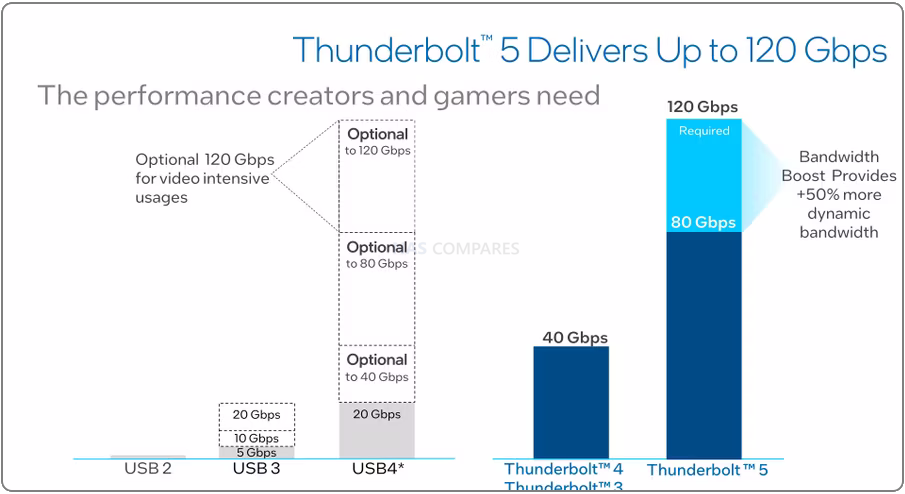
All About the Speed: Thunderbolt 5’s Promise Thunderbolt 5, Intel’s forthcoming connection technology, integrates the foundation of USB 4 version 2, making it possible to transfer data at a staggering 80Gbps—twice as fast as Thunderbolt 4. For gamers and creative professionals, this means the ability to connect high-resolution 8K monitors to their computing devices. Notably, Thunderbolt 5 can boost speeds up to 120Gbps for PCs-to-peripherals connections, albeit halving the return speed to 40Gbps.
Despite the impressive speed boost, average laptop users may not find a compelling use case for such advanced speeds, even if it can support larger monitors and high-end storage systems. But for those involved in intensive graphic design, gaming, and other high-demand activities, this speed bump could prove invaluable.
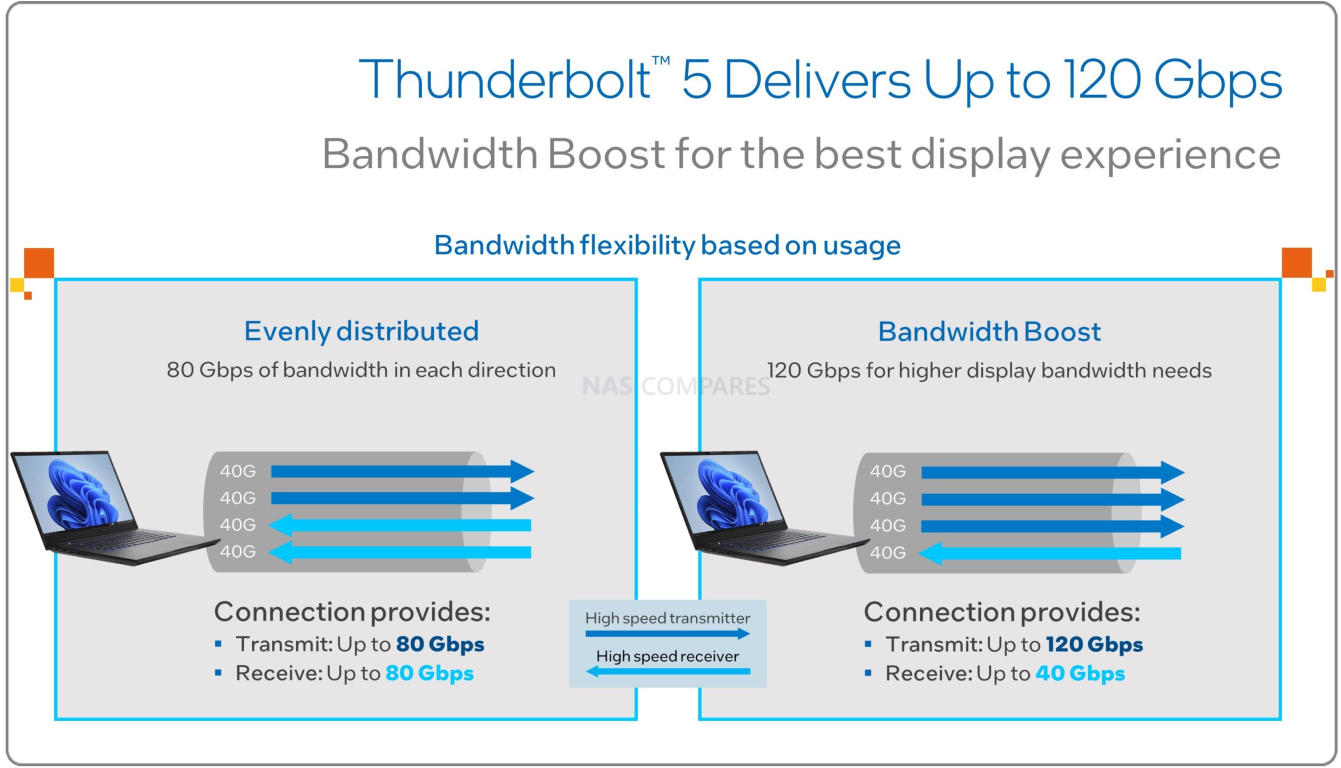
A Deep Dive: Thunderbolt 4 vs. Thunderbolt 5 The preceding Thunderbolt 4 became a staple for devices, especially in Intel and Apple laptops, since its introduction. However, Thunderbolt 5 is set to dethrone its predecessor with several significant upgrades:
- Bandwidth Boost: With up to 120Gbps in boosted mode, Thunderbolt 5 offers up to three times more bandwidth than Thunderbolt 4. This advancement means users can connect to multiple 8K HDR monitors or achieve gaming experiences with up to 580Hz displays.
- PCIe SSD Speeds: Made possible with Thunderbolt 5 support, via docking stations, TB5 allows plenty of bandwidth to play with! In preview testing on the official Intel YouTube channel (HERE) we saw a singe 8GB test file on a GEN4 SSD via a TB5 docking station hit 6,223MB/s and 5,383MB/s Sequential Read/Write in CrystalDiskMark via an 8GB test file:
- Display Streams: Thanks to increased bandwidth, Thunderbolt 5 can stream to three 4K monitors simultaneously at 144Hz.
- Charging Power: Another notable feature is the support for up to 240W charging. This introduces the potential for gaming laptops to solely rely on a Thunderbolt 5 port for charging.
- Device Integration: While Thunderbolt 5 might sound exciting, it’s expected to feature primarily in high-end creative or gaming devices. This suggests that Thunderbolt 4 will remain a standard feature in many devices for the foreseeable future. Though Thunderbolt technology has been presented as royalty-free software, suggesting its potential adoption in devices like AMD or Snapdragon, it’s expected that Intel and Apple devices will continue to dominate its use.
The imminent arrival of Thunderbolt 5 brings with it the promise of faster speeds, increased power, and better compatibility for high-end users. Yet, considering the history of its predecessor, one must wonder if the average user truly needs such advanced capabilities. Only time will tell if Thunderbolt 5 becomes a mainstream necessity or remains a luxury for the few.

| THUNDERBOLT 5 | THUNDERBOLT 4 | USB4 | USB 3.2 | |
|---|---|---|---|---|
| Data transfer rate | Up to 120 Gbps | Up to 80 Gbps | Minimum of 20 Gbps, 40 Gbps is optional.120 Gbps is optional with USB4 Version 2.0 | 5 Gbps (Gen 1), 10 Gbps (Gen 2), or 20 Gbps (Gen 2×2) |
| PC video requirements | Dual 6K | Dual 4K | One monitor | One monitor |
| PC data requirements* | PCIe: 64Gbps USB 3: 10Gbps** |
PCIe: 32Gbps USB 3: 10Gbps |
USB 3: 10Gbps | USB 3: 5Gbps |
| Required PC charging on at least one computer port | Required up to 140 W, available up to 240 W | Required up to 100 W, available up to 140 W | Available up to 240 W | Available up to 240 W |
| Required PC wake | Yes | Yes | No | No |
| Minimum PC port power for accessories | 15 W | 15 W | 7.5 W | 4.5 W |
| PC to PC networking* | 64Gbps | 32Gbps | N/A | N/A |
| Intel VT-d-based DMA protection required | Yes | Yes | No | No |
🔒 Join Inner Circle
Get an alert every time something gets added to this specific article!
This description contains links to Amazon. These links will take you to some of the products mentioned in today's content. As an Amazon Associate, I earn from qualifying purchases. Visit the NASCompares Deal Finder to find the best place to buy this device in your region, based on Service, Support and Reputation - Just Search for your NAS Drive in the Box Below
Need Advice on Data Storage from an Expert?
Finally, for free advice about your setup, just leave a message in the comments below here at NASCompares.com and we will get back to you. Need Help?
Where possible (and where appropriate) please provide as much information about your requirements, as then I can arrange the best answer and solution to your needs. Do not worry about your e-mail address being required, it will NOT be used in a mailing list and will NOT be used in any way other than to respond to your enquiry.
Need Help?
Where possible (and where appropriate) please provide as much information about your requirements, as then I can arrange the best answer and solution to your needs. Do not worry about your e-mail address being required, it will NOT be used in a mailing list and will NOT be used in any way other than to respond to your enquiry.

|
 |
| Where to Buy a Product | |||
|
|
    
|

|
VISIT RETAILER ➤ |
 |
    
|

|
VISIT RETAILER ➤ |
 |
    
|

|
VISIT RETAILER ➤ |
 |
    
|

|
VISIT RETAILER ➤ |
We use affiliate links on the blog allowing NAScompares information and advice service to be free of charge to you. Anything you purchase on the day you click on our links will generate a small commission which is used to run the website. Here is a link for Amazon and B&H. You can also get me a ☕ Ko-fi or old school Paypal. Thanks! To find out more about how to support this advice service check HERE
How Much RAM Do You Need in Your NAS?
A Buyer's Guide to Travel Routers - GET IT RIGHT, FIRST TIME
Jonsbo N6 DIY NAS Case Review
The Best Bits (and Worst Bits) of NAS of 2025!
Minisforum MS-02 Ultra Review
Minisforum N5 NAS, 6 Months Later - Better, Worse, the Same?
Access content via Patreon or KO-FI
Discover more from NAS Compares
Subscribe to get the latest posts sent to your email.


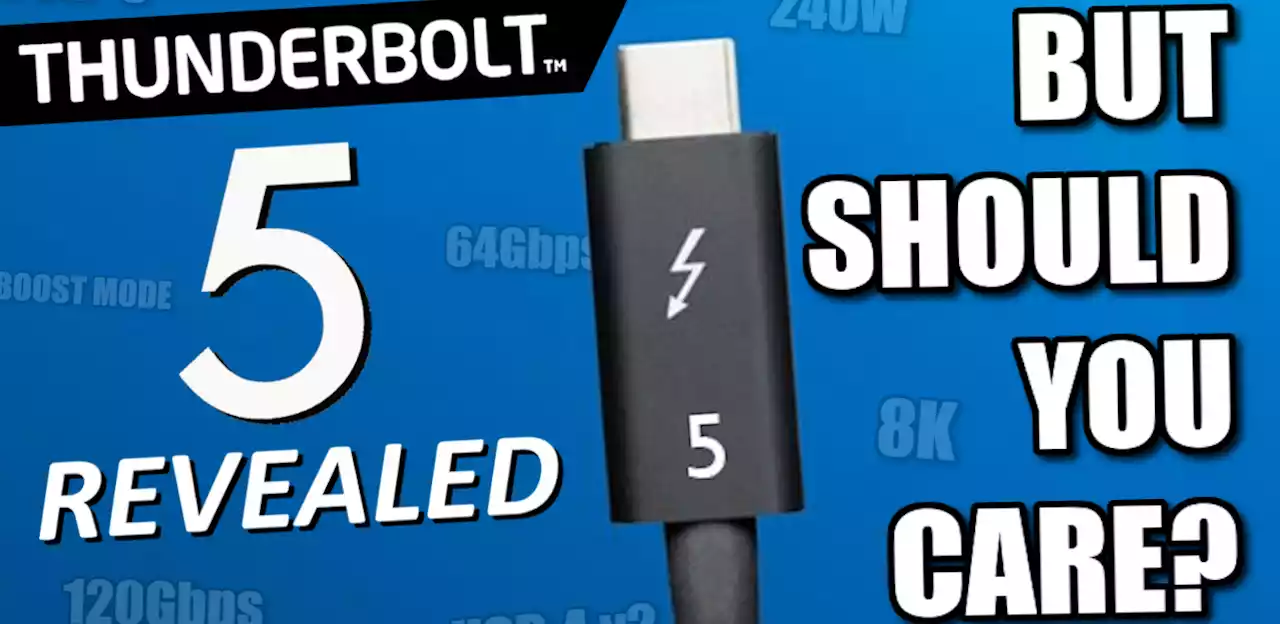

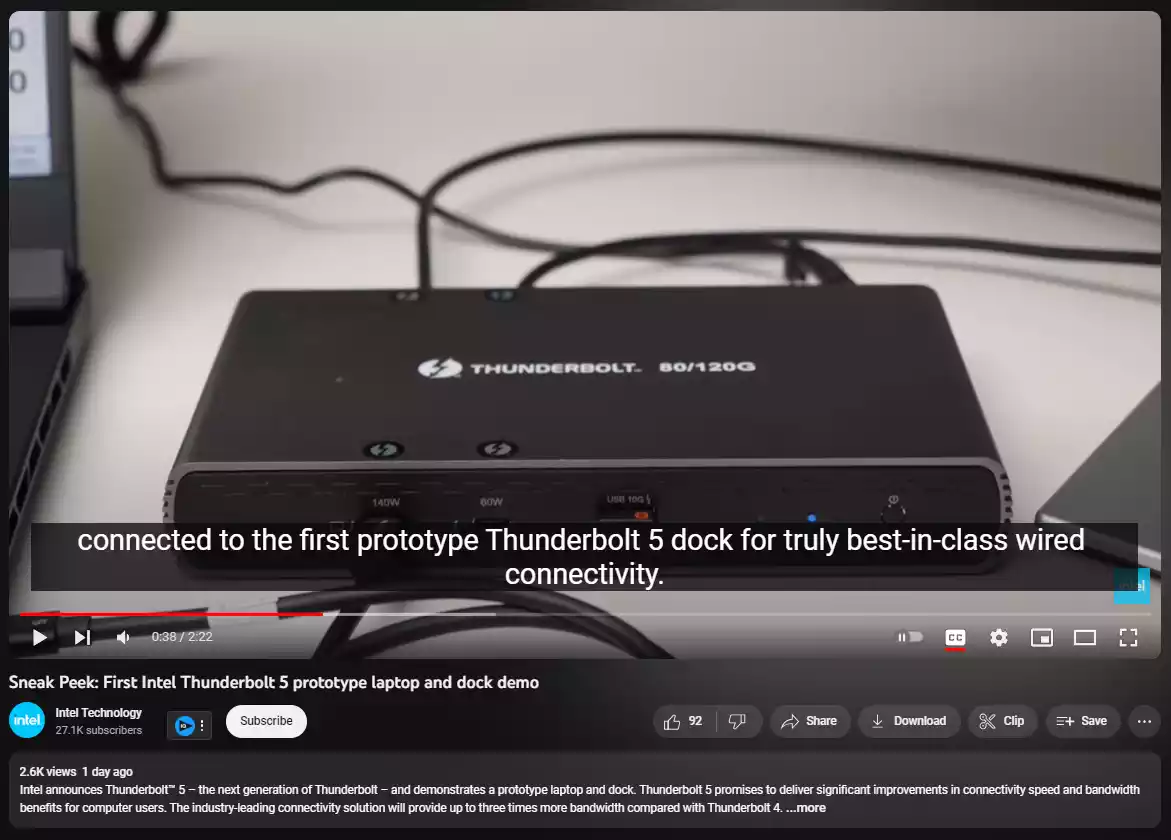
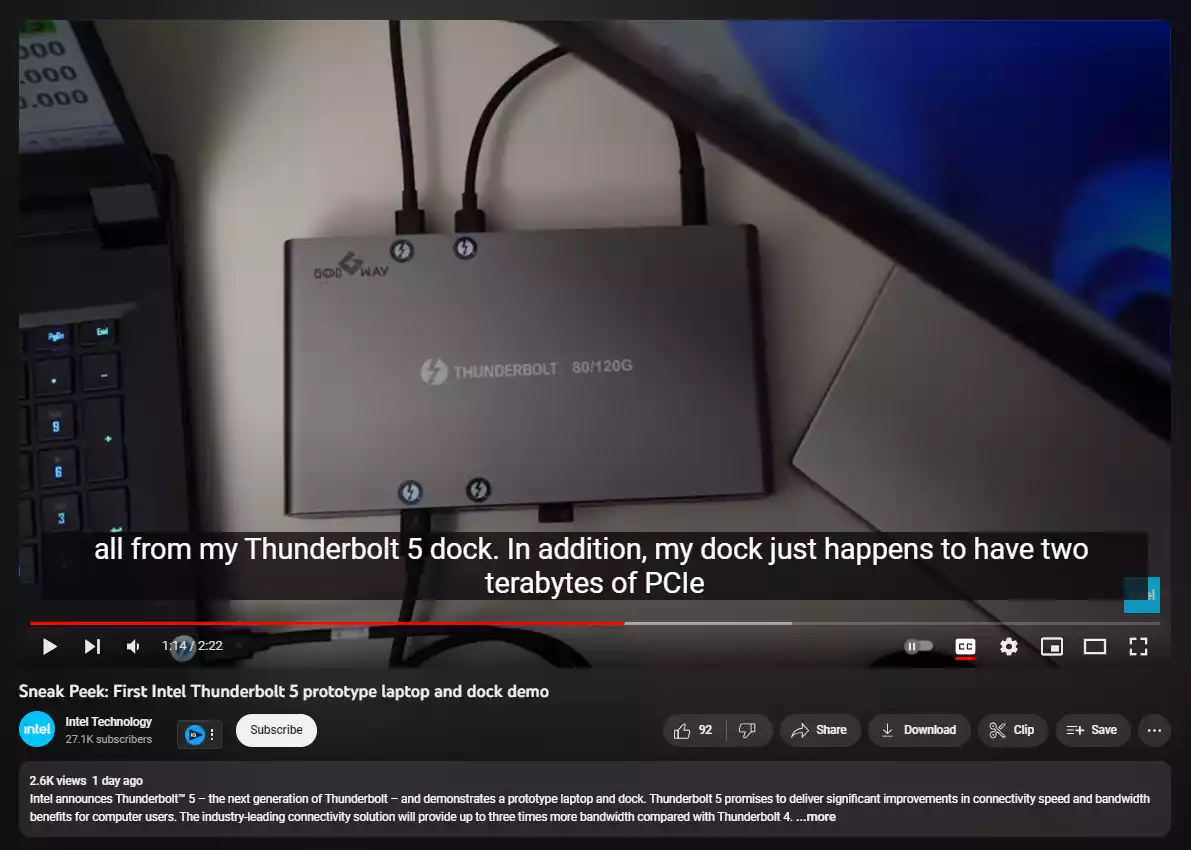



I’m still to see the day that we will have light small laptops without dGPUs powering eGPUs without latency losing performance. Hope thunderbolt 5 gets there, oculink gets close.
REPLY ON YOUTUBE
Release of Thunderbolt 5 cables and devices will drop prices for Thunderbolt 4 cables and devices.
REPLY ON YOUTUBE
Yeaps; Thunderbolt™ 5: The Next Generation of Connectivity https://www.youtube.com/watch?v=1wYj3S-hOIw
REPLY ON YOUTUBE
Those high speed signals need to have tightly controlled paths to travel. These can quickly lose timing over fractions of distance and then you’ve lost your signal integrity. Increased costs suck but I completely understand the quality control needed to make sure these cables work. And hey, its always backward compatible so if you get a TB4 cable you can still use that.
REPLY ON YOUTUBE
Thunderbolt 4 was a joke.
REPLY ON YOUTUBE
Nice watch????
REPLY ON YOUTUBE
There were nothing exciting about thunderbolt 4. The speeds were the same and they just added another lane for dual display or higher resolution
REPLY ON YOUTUBE
Your background is like an episode of that horder show on Netflix.
REPLY ON YOUTUBE
I’ve used Thunderbolt since my 2015 15″ MBP. slowly upgraded docks from a 5Gbps Plugable dock (Still in service with my Fold 4 for Dex duties), to a Wavlink TB3 and Caldigit TB3+ , both currently working (the Wavlink with my iPad pro 12.9″ M1 and the TS3+ with my Mac Studio/M2 MBA ), until you have enjoyed the flexibility of TB3/TB4 you probably will not understand the joy of connecting a single cable and converting a Tablet/Laptop and it becoming a desktop.
So I will be ordering a TB5 Dock (especially with up to 120Gbps available in asymmetric/turbo mode), its very much like 10Gbps, it seems extravagant until you have used it and have to go back to gigabit. We just need apple to announce support and I will be a happy chappy
REPLY ON YOUTUBE
Hi Robbie, I just bought a Synology 1522+ and added a 10 Gb Ethernet port to it. What 10 Gb Ethernet switch do you recommend and do you have a link for it on Amazon?
REPLY ON YOUTUBE
Just 12? Sounds very weak.
REPLY ON YOUTUBE
It seems that using usb 3.2 g2 or g1 for connecting drives or ethernet adapters is sketchy on Unix bases o/s’s (truenas, unraid, freeBSD, etc.) . Is that also true for thunderbolt adapters?
REPLY ON YOUTUBE
Due to (Intel) licensing (it is not as much as an “open standard” as USB is, e.g) TB has always been quite expensive compared to its (speed) benefits. As you may know, each(!) TB connector of a TB cable always does have a very small chip inside on each end of the cable, which makes the cable more complex and expensive. And lastly, TB in combination with NAS, *always* makes the NAS behave like a DAS. Which is fine, unless you are using TB for other devices (screens, other DAS devices etc) in that TB chain, than the order on how you daisy-chain becomes very important (and may not always work). Especially when you link (e.g) TB3 and TB4 devices into 1x chain. There is downwards compatibility within TB but it does dictate which needs to link first to the host (for optimal performance, compatibility etc)
BTW, TB standard also puts a limit indeed on maximum cable-lengths (usually 2.3 metres) unless you can afford a very expensive TB optical cable.
In all, TB in its current iterations, is a nice solution for those who need the speed but are okay to sit about (max) 2 metres away from their NAS) and 10GBe networking can not resolve their requirements. And can afford the higher costs of a TB implementation. In real life it is often 4K/8K video-editing that makes TB a useful implementation. But most certainly at a cost; both the investments (costs) and the complexity (how to connect it all, maximising performance etc).
We do use TB, including said very expensive optical TB cables, but more & more we try to use 10GBe networking instead, where possible….
REPLY ON YOUTUBE
How does it only have 20 Gbps networking?
REPLY ON YOUTUBE
Thks Robbie &;
!!!!!!HEY!!!!! Synology ; USB3.0 & RJ-45 1Gb ethernet just ain’t going to cut-the-mustard no-darn-more (take a hint wills-yous 😉
REPLY ON YOUTUBE
I would challenge your assertion that cable costs are rising.
Intel donated thunderbolt to the usb-if and it is now used to underpin usb4. So usb4 cables are compatible with thunderbolt 3/4. And support 40 gbps and up to 240W power delivery. Usb4 cables can now be had for $20 on Amazon, which is a dramatic decline in price compared to what tb3/tb4 cables used to cost. Current certified usb4 cables have better specs than thunderbolt 4 cables (usb4 cables support up to 240W whereas the tb4 cables only support up to 100W).
So my belief is that as more usb4 devices and cables come to market, there will be downward pressure on pricing. AsMedia’s usb4 controller is coming to market you can find it in certain nvme enclosures from companies such as Zike and Hyper and Satechi. They’re faster than tb3 enclosures but yet cost less.
I think we’re about to see an explosion of a usb4/thunderbolt 5 ecosystem. With decent pricing.
REPLY ON YOUTUBE
Straight dont care. My data is committed to NAS and I’d have to be going down an SFP28 25G path on the NAS, and switch(es) and computer NIC even to begin to care.
REPLY ON YOUTUBE
let’s take a broader look, from NAS perspective,
PCIe NVME 3.0 and 4.0 drives are becoming more and more affordable, and few NAS manufacturers already make “all-NVME” NASes (with various caveats and quirks),
let’s assume people want a portable (?) workstation laptop, plug just one cable and get everything including power delivery, display, storage etc… Thunderbolt5 really starts to make sense, and at that point hybrid DAS+NAS will be a better option than expensive and inefficient 100Gbe networking
REPLY ON YOUTUBE
I paid over $500 for a now, NAS-doorstop! The fact that it had the latest speed of the day seems so meaningless today!
Every single advance made doesn’t mean shit if the overall device can’t thrive and grow. We must demand that we stop buying features and start buying structures that can grow
with time.
REPLY ON YOUTUBE
Thunderbolt just leaves me confused. I really don’t see the point of it. But, even more, I wonder about its support. My motherboard (Gigabyte B550 VISION D-P) has a Thunderbolt 3 port on it. The last driver for it on Gigabyte’s site is version 1.41.890.0 from 09 Jun 2020 (over 3 years ago). On Intel’s site, I see drivers that are years newer. But, I can’t install them because Intel wants Gigabyte to provide the drivers to their customers. A bit upsetting.
REPLY ON YOUTUBE
If you think a Thunderbolt 4 cable is expense just wait until you see the price of a NAS that can sustain 80 Gbps.
REPLY ON YOUTUBE
Thunderbolt 5 really sounds like everything you’d want. But as with TB4 I have the fear it’ll be prohibitively expensive for most usecases. Most of the time I’d rather take multiple cables instead of overpaying just to reduce the amount of cables I have. For the price of a TB4 Dock I can get a 2nd hand Laptop.
REPLY ON YOUTUBE
typo on the title is not 12GB/s is 120GB/s
REPLY ON YOUTUBE
For a long time I had hoped that Thunderbolt adoption on monitors would go mainstream. That hasn’t really happened as models which support it are very few and far between. Brands such as Dell only offer a USB-C option. Of those which support TB3 or TB4, very few have a 2nd thunderbolt port to support daisy chain. Those which do are eye wateringly expensive. Last week I gave up waiting for reasonably priced options and just purchased two DisplayPort monitors to use with my TB3 docking station.
REPLY ON YOUTUBE